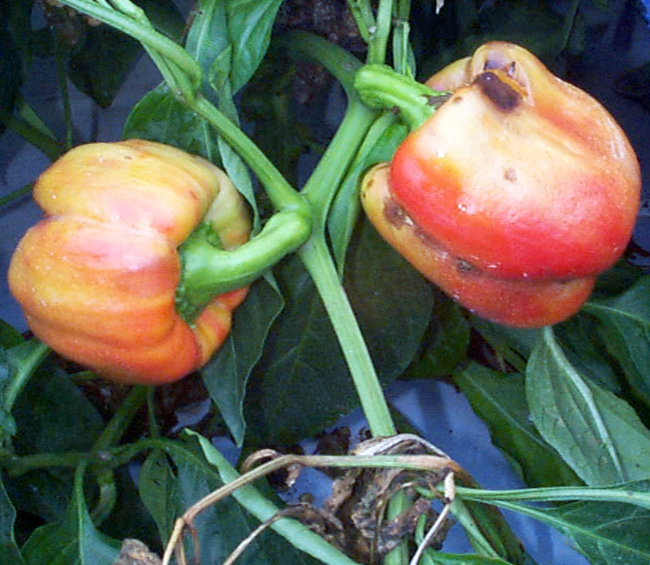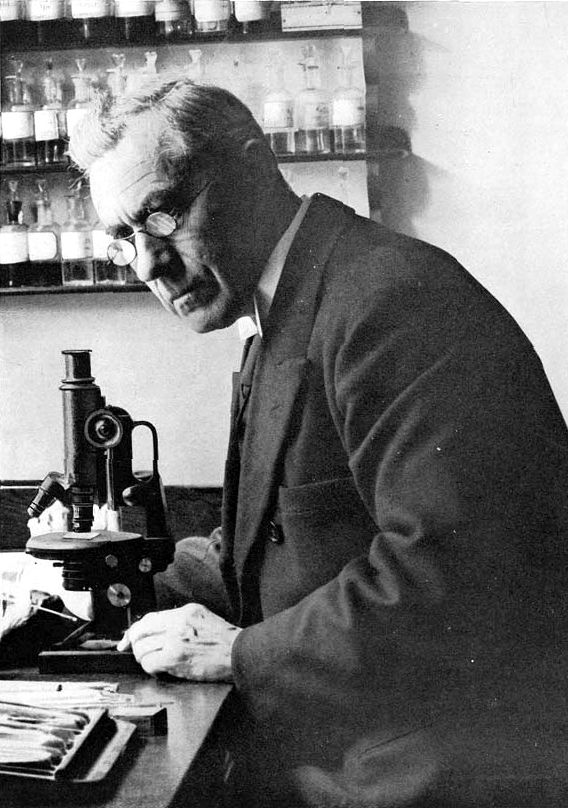|
Plant Viruses
Plant viruses are viruses that affect plants. Like all other viruses, plant viruses are obligate intracellular parasites that do not have the molecular machinery to replicate without a host. Plant viruses can be pathogenic to higher plants. Most plant viruses are rod-shaped, with protein discs forming a tube surrounding the viral genome; isometric particles are another common structure. They rarely have an envelope. The great majority have an RNA genome, which is usually small and single stranded (ss), but some viruses have double-stranded (ds) RNA, ssDNA or dsDNA genomes. Although plant viruses are not as well understood as their animal counterparts, one plant virus has become very recognizable: ''tobacco mosaic virus'' (TMV), the first virus to be discovered. This and other viruses cause an estimated US$60 billion loss in crop yields worldwide each year. Plant viruses are grouped into 73 genera and 49 families. However, these figures relate only to cultivated plants, which ... [...More Info...] [...Related Items...] OR: [Wikipedia] [Google] [Baidu] |
Pepper Mild Mottle Virus
''Pepper mild mottle virus'' (PMMoV) is a plant pathogenic virus that occurs worldwide on species of field grown bell, hot and ornamental pepper species. It is caused by members of the plant virus genus ''Tobamovirus''- otherwise known as the tobacco mosaic virus family. ''Tobamovirus'' are viruses that contain positive sense RNA genomes that infect plants. Symptoms of the disease vary depending on the cultivar. Typical symptoms include the chlorosis of leaves, stunting, and distorted and lumpy fruiting structures. The virus is spread by mechanical transmission and infected seeds. Avoidance is the best means of controlling the disease because once a plant is infected it cannot be treated. Only seeds that have been tested and treated for the pathogen should be planted. History The origin of PMMoV has been linked to ''Tomato mosaic virus'', as they both reside in the ''Tobacco mosaic virus'' family. The ''Tunisian Journal of Plant Protection'' brought about the link between PMMoV to ... [...More Info...] [...Related Items...] OR: [Wikipedia] [Google] [Baidu] |
Cell Wall
A cell wall is a structural layer surrounding some types of cells, just outside the cell membrane. It can be tough, flexible, and sometimes rigid. It provides the cell with both structural support and protection, and also acts as a filtering mechanism. Cell walls are absent in many eukaryotes, including animals, but are present in some other ones like fungi, algae and plants, and in most prokaryotes (except mollicute bacteria). A major function is to act as pressure vessels, preventing over-expansion of the cell when water enters. The composition of cell walls varies between taxonomic group and species and may depend on cell type and developmental stage. The primary cell wall of land plants is composed of the polysaccharides cellulose, hemicelluloses and pectin. Often, other polymers such as lignin, suberin or cutin are anchored to or embedded in plant cell walls. Algae possess cell walls made of glycoproteins and polysaccharides such as carrageenan and agar that are absent ... [...More Info...] [...Related Items...] OR: [Wikipedia] [Google] [Baidu] |
Microscopic
The microscopic scale () is the scale of objects and events smaller than those that can easily be seen by the naked eye, requiring a lens (optics), lens or microscope to see them clearly. In physics, the microscopic scale is sometimes regarded as the scale between the macroscopic scale and the quantum realm, quantum scale. Microscopic units and measurements are used to classify and describe very small objects. One common microscopic length scale unit is the micrometre (also called a ''micron'') (symbol: μm), which is one millionth of a metre. History Whilst compound microscopes were first developed in the 1590s, the significance of the microscopic scale was only truly established in the 1600s when Marcello Malpighi, Marcello Malphigi and Antonie van Leeuwenhoek microscopically observed frog lungs and microorganisms. As microbiology was established, the significance of making scientific observations at a microscopic level increased. Published in 1665, Robert Hooke’s book Mi ... [...More Info...] [...Related Items...] OR: [Wikipedia] [Google] [Baidu] |
Contagium Vivum Fluidum
''Contagium vivum fluidum'' (Latin: "contagious living fluid") was a phrase first used to describe a virus, and underlined its ability to slip through the finest-mesh filters then available, giving it almost liquid properties. Martinus Beijerinck (1851–1931), a Dutch microbiologist and botanist, first used the term when studying the tobacco mosaic virus, becoming convinced that the virus had a liquid nature. In 1892, Dmitri Ivanovsky had discovered that the cause of tobacco mosaic disease could pass through Chamberland's porcelain filter. He noted these findings but felt that they could only have resulted from a cracked filter. It was left to Beijerinck, in 1898, to put forward the idea that the pathogen was small enough to pass through the filter routinely used to trap bacteria. Ivanovsky, irked that Beijerinck had not cited him, recreated Beijerinck's experimental set-up and demonstrated that particles of ink were small enough to pass through the filter, thus leaving the p ... [...More Info...] [...Related Items...] OR: [Wikipedia] [Google] [Baidu] |
Beijerinck
Martinus Willem Beijerinck (, 16 March 1851 – 1 January 1931) was a Dutch microbiologist and botanist who was one of the founders of virology and environmental microbiology. He is credited with the discovery of viruses, which he called "''contagium vivum fluidum''". Life Early life and education Born in Amsterdam, Beijerinck studied at the Technical School of Delft, where he was awarded the degree of Chemical Engineer in 1872. He obtained his Doctor of Science degree from the University of Leiden in 1877. At the time, Delft, then a Polytechnic, did not have the right to confer doctorates, so Leiden did this for them. He became a teacher in microbiology at the Agricultural School in Wageningen (now Wageningen University) and later at the ''Polytechnische Hogeschool Delft'' (Delft Polytechnic, currently Delft University of Technology) (from 1895). He established the Delft School of Microbiology. His studies of agricultural and industrial microbiology yielded fundamental disco ... [...More Info...] [...Related Items...] OR: [Wikipedia] [Google] [Baidu] |
Microorganisms
A microorganism, or microbe,, ''mikros'', "small") and ''organism'' from the el, ὀργανισμός, ''organismós'', "organism"). It is usually written as a single word but is sometimes hyphenated (''micro-organism''), especially in older texts. The informal synonym ''microbe'' () comes from μικρός, mikrós, "small" and βίος, bíos, "life". is an organism of microscopic size, which may exist in its single-celled form or as a colony of cells. The possible existence of unseen microbial life was suspected from ancient times, such as in Jain scriptures from sixth century BC India. The scientific study of microorganisms began with their observation under the microscope in the 1670s by Anton van Leeuwenhoek. In the 1850s, Louis Pasteur found that microorganisms caused food spoilage, debunking the theory of spontaneous generation. In the 1880s, Robert Koch discovered that microorganisms caused the diseases tuberculosis, cholera, diphtheria, and anthrax. Because micr ... [...More Info...] [...Related Items...] OR: [Wikipedia] [Google] [Baidu] |
Chamberland Filter
A Chamberland filter, also known as a Pasteur–Chamberland filter, is a porcelain water filter invented by Charles Chamberland in 1884. It was developed after Henry Doulton, Henry Doulton's ceramic water filter of 1827. It is similar to the Berkefeld filter in principle. Design The filter consists of a permeable unglazed porcelain tube (called bisque) that contains a ring of enameled porcelain through which the inflow pipe fits. The core of the porcelain is made up of a metal pipe with holes through which water flows out and is collected. Inflow is pressurized so filtration occurs under force. There are 13 types: ''L1'' to ''L13''. L1 filters have the coarsest pore size while L13 have the finest. Usefulness The Pasteur-Chamberland filter is as useful as other ceramic and porcelain filters. It is a good bacterial water filter used mainly as a high volume water filter.Textbook of Microbiology by Ananthanarayan and Panikar, The filter works more quickly when the water suppli ... [...More Info...] [...Related Items...] OR: [Wikipedia] [Google] [Baidu] |
Disease
A disease is a particular abnormal condition that negatively affects the structure or function of all or part of an organism, and that is not immediately due to any external injury. Diseases are often known to be medical conditions that are associated with specific signs and symptoms. A disease may be caused by external factors such as pathogens or by internal dysfunctions. For example, internal dysfunctions of the immune system can produce a variety of different diseases, including various forms of immunodeficiency, hypersensitivity, allergies and autoimmune disorders. In humans, ''disease'' is often used more broadly to refer to any condition that causes pain, dysfunction, distress, social problems, or death to the person affected, or similar problems for those in contact with the person. In this broader sense, it sometimes includes injuries, disabilities, disorders, syndromes, infections, isolated symptoms, deviant behaviors, and atypical variations of structur ... [...More Info...] [...Related Items...] OR: [Wikipedia] [Google] [Baidu] |
DsRNA
Ribonucleic acid (RNA) is a polymeric molecule essential in various biological roles in coding, decoding, regulation and expression of genes. RNA and deoxyribonucleic acid ( DNA) are nucleic acids. Along with lipids, proteins, and carbohydrates, nucleic acids constitute one of the four major macromolecules essential for all known forms of life. Like DNA, RNA is assembled as a chain of nucleotides, but unlike DNA, RNA is found in nature as a single strand folded onto itself, rather than a paired double strand. Cellular organisms use messenger RNA (''mRNA'') to convey genetic information (using the nitrogenous bases of guanine, uracil, adenine, and cytosine, denoted by the letters G, U, A, and C) that directs synthesis of specific proteins. Many viruses encode their genetic information using an RNA genome. Some RNA molecules play an active role within cells by catalyzing biological reactions, controlling gene expression, or sensing and communicating responses to cellular signa ... [...More Info...] [...Related Items...] OR: [Wikipedia] [Google] [Baidu] |
SiRNA
Small interfering RNA (siRNA), sometimes known as short interfering RNA or silencing RNA, is a class of double-stranded RNA at first non-coding RNA molecules, typically 20-24 (normally 21) base pairs in length, similar to miRNA, and operating within the RNA interference (RNAi) pathway. It interferes with the expression of specific genes with complementary nucleotide sequences by degrading mRNA after transcription, preventing translation. Text was copied from this source, which is available under Creative Commons Attribution 4.0 International License Structure Naturally occurring siRNAs have a well-defined structure that is a short (usually 20 to 24- bp) double-stranded RNA (dsRNA) with phosphorylated 5' ends and hydroxylated 3' ends with two overhanging nucleotides. The Dicer enzyme catalyzes production of siRNAs from long dsRNAs and small hairpin RNAs. siRNAs can also be introduced into cells by transfection. Since in principle any gene can be knocked down by a syntheti ... [...More Info...] [...Related Items...] OR: [Wikipedia] [Google] [Baidu] |
Innate Immune System
The innate, or nonspecific, immune system is one of the two main immunity strategies (the other being the adaptive immune system) in vertebrates. The innate immune system is an older evolutionary defense strategy, relatively speaking, and is the dominant immune system response found in plants, fungi, insects, and primitive multicellular organisms (see Beyond vertebrates).. The major functions of the innate immune system are to: * recruit immune cells to infection sites by producing chemical factors, including chemical mediators called cytokines * activate the complement cascade to identify bacteria, activate cells, and promote clearance of antibody complexes or dead cells * identify and remove foreign substances present in organs, tissues, blood and lymph, by specialized white blood cells * activate the adaptive immune system through antigen presentation * act as a physical and chemical barrier to infectious agents; via physical measures such as skin and chemical measures such a ... [...More Info...] [...Related Items...] OR: [Wikipedia] [Google] [Baidu] |






